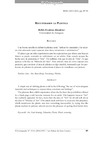Identificador persistente para citar o vincular este elemento:
https://accedacris.ulpgc.es/jspui/handle/10553/5721
| Campo DC | Valor | idioma |
|---|---|---|
| dc.contributor.author | Escalona Almudevar, Rubén | en_US |
| dc.date.accessioned | 2011-07-08T02:31:00Z | - |
| dc.date.accessioned | 2018-03-08T08:55:30Z | - |
| dc.date.available | 2011-07-08T04:00:18Z | - |
| dc.date.available | 2018-03-08T08:55:30Z | - |
| dc.date.issued | 2006 | en_US |
| dc.identifier.uri | https://accedacris.ulpgc.es/handle/10553/5721 | - |
| dc.description.abstract | Una forma sencilla de definir la plástica sería: “utilizar los materiales y las técnicas más adecuados para expresar unas ideas, emociones o sentimientos.” El placer que un niño experimenta ante las expectativas que ofrece una hoja en blanco se puede convertir en sufrimiento en un adulto. Esto sucede porque ha hecho acto de presencia el “Arte”. En realidad, más que la idea de “Arte”, lo que aparece es la idea de “Historia del Arte”. Este artículo trata de cómo superar este prejuicio, que convierte el área de plástica en algo inasible, intentando que los profesores de plástica de primaria redescubran el placer de mancharse con pintura. | en_US |
| dc.description.abstract | A simple way of defining plastic could be the following: “the use of most adequate materials and techniques to express ideas, emotions and feelings”. The pleasure that a child experiences when she/he faces the possibilities offered by a blank page could become torment for an adult. This happens because “Art” has suddenly appeared. In fact, more than the idea of “Art” we should talk about the idea of “History of Art”. This article deals with how to overcome this prejudice, which transforms the plastic area into something inaccessible, by trying that the plastic teachers in primary schools recover the pleasure of getting their hands dirty. | en_US |
| dc.format | application/pdf | es |
| dc.language | spa | en_US |
| dc.relation.ispartof | El Guiniguada | en_US |
| dc.source | El Guiniguada. Las Palmas de Gran Canaria: Servicio de Publicaciones, Universidad de Las Palmas de Gran Canaria, 1984- ISSN 0213-0610, n.15-16, 2006-2007, p. 89 | en_US |
| dc.subject | 58 Pedagogía | en_US |
| dc.subject.other | Arte | en_US |
| dc.subject.other | Buen dibujo | en_US |
| dc.subject.other | Enseñanza | en_US |
| dc.subject.other | Plástica | en_US |
| dc.title | Recuperamos la plástica | en_US |
| dc.type | info:eu-repo/semantics/article | en_US |
| dc.type | Article | en_US |
| dc.compliance.driver | 1 | es |
| dc.identifier.absysnet | 235347 | - |
| dc.identifier.crisid | - | - |
| dc.investigacion | Artes y Humanidades | en_US |
| dc.rights.accessrights | info:eu-repo/semantics/openAccess | es |
| dc.type2 | Artículo | en_US |
| dc.identifier.external | - | - |
| dc.identifier.ulpgc | Sí | es |
| dc.description.sellofecyt | Sello FECYT | |
| dc.description.esci | ESCI | |
| dc.description.erihplus | ERIH PLUS | |
| item.fulltext | Con texto completo | - |
| item.grantfulltext | open | - |
| Colección: | Guiniguada. 2ª Etapa. n.15-16, 2006-2007 Artículos | |
Visitas
97
actualizado el 24-ago-2024
Descargas
88
actualizado el 24-ago-2024
Google ScholarTM
Verifica
Comparte
Exporta metadatos
Los elementos en ULPGC accedaCRIS están protegidos por derechos de autor con todos los derechos reservados, a menos que se indique lo contrario.
